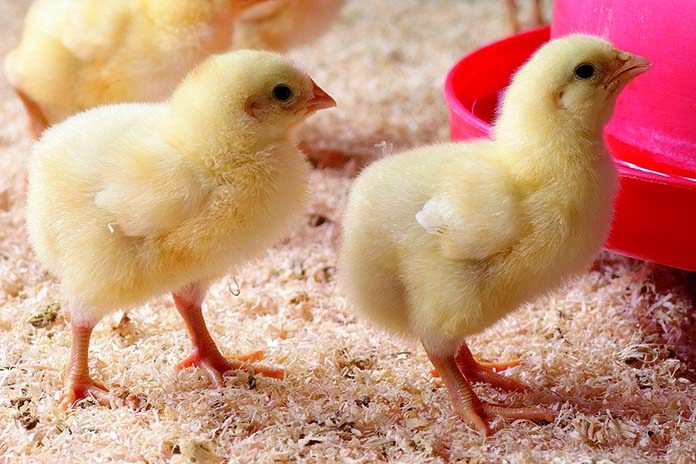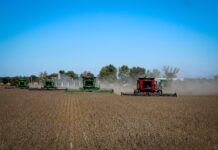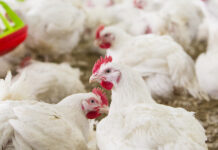
Seven dietary treatments consisting of a ground grain control and six treatments with pre- and post-pellet whole grain inclusions of 7.5, 15.0 and 30.0% were offered to a total of 252 male Ross 308 broiler chicks from 7 to 28 days post-hatch. With the post-pellet approach, whole grain and pelleted concentrate were offered in separate feed trays to give birds an unhindered opportunity to select between the two ration components. The 30% post-pellet whole grain treatment generated the most efficient feed conversion of 1.260, which represented an improvement of 7.01% (1.260 versus 1.365 P<0.01) in comparison to the 30% pre-pellet counterparts. Also, 30% post-pellet whole wheat generated the greatest responses in AME and ME:GE ratios. Birds offered 30% post-pellet whole grain exhibited the strongest preference for a high protein diet, consuming proportionally more pelleted concentrate and less whole grain than the 7.5 and 15% post-pellet whole grain treatments. Thus, the opportunity of choice feeding and the selection of higher protein dietary intakes contributed to enhanced performance under whole grain feeding regimes.
Whole grain feeding (WGF) involves the partial substitution of ground grain with whole grain in boiler diets. Whole grain (WG), usually wheat, may be added either prior to (pre-pellet) or following (post-pellet) steam-pelleting. WGF generates heavier and presumably more functional gizzards, which are thought to be the genesis of responses in feed conversion ratios (FCR) and energy utilisation. However, post-pellet WGF also provides broilers with the opportunity to select between the ‘low protein’ WG and the ‘high protein’ pelleted concentrate component of the ration, which have similar energy densities. As WG inclusions increase so does the differential in protein content between the two components. Cumming (1992) championed WGF on the basis that “each fowl can accurately select its own nutritional requirements” as a result of free choice-feeding. To investigate this aspect, 7.5, 15.0 and 30% post-pellet WG rations were offered with whole wheat and pelleted concentrate in two separate feeding trays to provide birds with an unhindered opportunity to select or choice-feed, and to permit the individual feed intake recording of the two components. Therefore, WG inclusions of 7.5, 15 and 30% were applied to both pre-pellet and post-pellet WGF regimes to compare these dietary treatments with a conventional ground-grain control diet. Seven dietary treatments with six replicates each (6 birds per cage) were offered to a total of 252 male Ross 308 broiler chicks from 7 to 28 days post-hatch, the diets were identical (532.8 g/kg wheat, 310.0 g/kg soybean meal, 218.6 g/kg protein, 336 g/kg starch) except for the presentation of wheat. A wheat-soy steam-pelleted diet, containing ground grain (3.2 hammer-mill screen), which met Ross 308 nutrient specifications served as the control. Pre- and post-pellet whole wheat inclusions were added in substitution for ground wheat and comprised the remaining six treatments with WG inclusion levels of 7.5, 15.0 and 30.0%.
The post-pellet WG and the corresponding pelleted concentrate were offered separately and feed was added daily into two adjacently positioned feeding trays to permit the monitoring of feed intakes of both components. When appropriate, wheat was ground through a 3.2 mm hammer-mill screen prior to steam-pelleting through a 4.00 mm die at a 75°C conditioning temperature. A non-starch polysaccharide degrading enzyme (Danisco Xylanase, 16,000 BXU/kg) was added across all wheat-based diets. Growth performance, gizzard characteristics and total tract energy utilisation were determined by standard procedures described in Moss et al. (2017). Data were analysed using IBM® SPSS® Statistics (IBM Corporation. Somers, NY). A probability level of less than 5% was considered statistically significant. Overall, the Ross 308 2014 growth performance objectives were surpassed. Also, absolute and relative ration components and starch and protein intakes of birds offered separate post-pellet WG diets are tabulated.
WGF did not significantly influence weight gain, but significantly influenced feed intake (P<0.001) with 15 and 30% post-pellet WG depressing feed intakes relative to the control. On the basis of a pair-wise comparison, the 30% post-pellet WG treatment improved FCR by 7.69% (1.260 versus 1.365; P<0.01) in comparison to the ground grain control. Pre- and post-pellet WG significantly increased relative gizzard weights (P<0.001), with 30% post-pellet WG generating the largest increase of 37.3% (19.23 versus 14.01 g/kg; P<0.001) by a pairwise comparison. Post-pellet WG inclusions of 15 and 30% and the 30% pre-pellet inclusion significantly increased relative gizzard contents, with the 30% pre-pellet WG treatment generating the largest increase of 51.1% (9.79 versus 6.48 g/kg). Pre-pellet WG inclusions of 7.5 and 15% and post-pellet inclusions of 15 and 30% significantly reduced gizzard pH. All post-pellet WG inclusions significantly increased average metabolisable energy (AME) and metabolisable energy to gross energy (ME:GE) ratios (P<0.001), with the 30% post-pellet inclusion enhancing AME by 1.31 MJ (13.25 versus 11.94 MJ/kg; P<0.001) and ME:GE ratios by 9.88% (0.756 versus 0.688; P<0.001).
Ostensibly, birds offered post-pellet WG treatments should have consumed 7.5, 15.0 and 30.0% whole wheat to maintain a constant dietary protein intake of 226 g/kg. However, the actual consumptions of WG were 8.4, 8.2 and 16.4%, respectively. WG inclusion was linearly correlated to starch to protein ratios (r = 0.689; P<0.005), where higher WG inclusions resulted in a significant condensation (P<0.001) of starch to protein intake ratios from 0.83 (7.5% WG) to 0.55 (30.0% WG) as birds elected to increase their relative protein intakes given the unfettered opportunity to select between the two ration components.
The growth performance response observed in the current study followed the trends discussed in Liu et al. (2015), where WGF maintained weight gain, reduced feed intake and enhanced feed conversion in a number of feeding studies. However, the hallmark response to WGF regimes is increased relative gizzard weights. In the current study, post-pellet WGF generated a robust increase of 37% (19.23 versus 14.01) in gizzard weight, which was correlated with FCR (r = -0.457; P<0.005), AME (r = 0.775; P<0.001) and ME:GE (r = 0.759; P<0.001). Thus, the clear implication is that heavier, and presumably more functional, gizzards advantaged feed conversion and nutrient utilisation in broiler chickens.
Nevertheless, heavier gizzard weights may not be the only consequence of WGF regimes, which enhance performance. Gous and Swatson (2000) found that broiler chicks will attempt to maximise performance by selecting the best possible combination of protein sources when given the opportunity. Forbes and Covasa (1995) support the concept that choice feeding is contributing to the responses observed in broiler chickens under WGF regimes. Birds offered post-pellet WG had the unhindered opportunity to choice feed by selecting between the pelleted concentrate (high protein) and WG (low protein) components provided in separate feed trays. It is evident that birds offered the 15 and 30% post-pellet WG treatments did not consume the entire WG component allocated, and instead selected a proportionally higher protein to starch intake. While this outcome was not anticipated, Amerah and Ravindran (2008) observed essentially similar findings with birds displaying a preference for the pelleted concentrate over WG. Additionally, across all treatments, starch to protein ratios were correlated with FCR (r = -0.382; P<0.02), AME (r = 0.698; P<0.001) and ME:GE (r = 0.683; P<0.001), such that the higher the starch intake, the poorer the feed conversion and energy utilisation. The 30% WG treatment provided the greatest opportunity for selection as the analysed protein content of the pelleted concentrate increased from 234 to 246 and 273 g/kg with increasing WG inclusions. As a consequence of selection, birds elected to consume dietary intakes with protein contents of 226, 237 and 253 g/kg, respectively.
References are available on request
From the Proceedings of the Austrialian Poultry Science Symposium
















